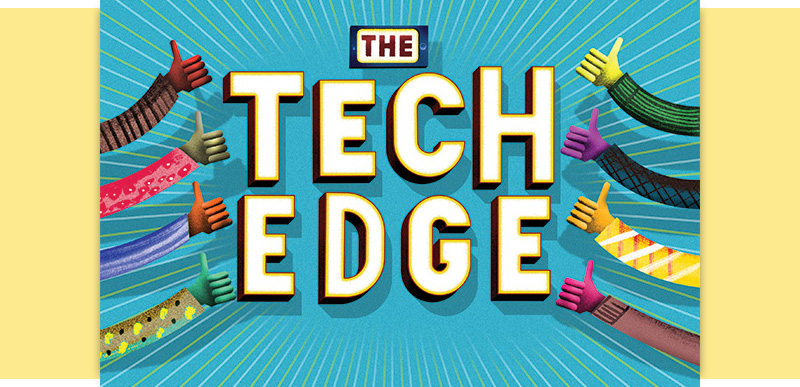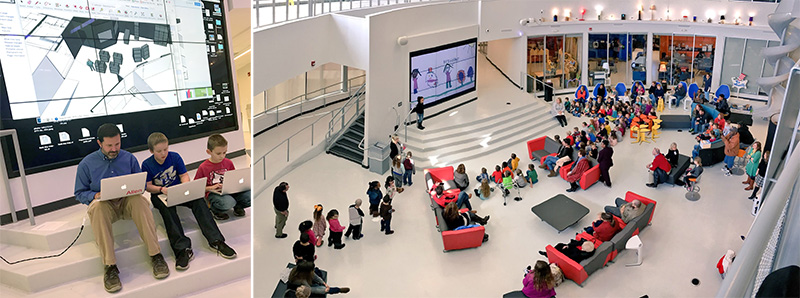Tech Leaders: STEM & STEAM Dreamers
With projects ranging from aquaponics to breakerspaces, these innovators maximize tech's creative potential. It starts in the library.

What makes a tech leader? The 16 influencers we profile this month have found innovative ways to leverage technology to enhance STEM and STEAM learning, amplify student voices, and more. From activism to aquaponics and breakerspaces to self-publishing centers, their pursuits inspire. It all starts in the library. Here, read about six STEM and STEAM trailblazers.
 |
Left: James Allen with students; right: the EDhub. |
Six Tech Influencers
|
James Allen
Teacher Librarian, Eminence (KY) Independent Schools
Walk into the library at the Eminence Independent Schools campus and you’ll be greeted by flying drones, a giant wall of computer monitors, an aquaponics lab, and a slide connecting the first and second floors. The rural K–12 school’s new library, dubbed the EDhub, or the Experimental DaVinci Hybrid Ultra Bibliotheca, was built with the help of a $6 million nickel property tax and opened three years ago. The district superintendent and others envisioned the space out of a desire to rethink instruction with a STEAM focus. Now, along with books, students have access to eight different labs that can be used for taking tours with virtual reality (VR) goggles, filming projects for class, and a LEGO wall. Still, “the things aren’t really the important part,” says librarian James Allen, also past-president of the Kentucky Association of School Libraries. “Providing the best for our students, above and beyond the standard curriculum, is the goal.” That means design thinking way outside of the box, using lab tools including Tinkercad, SketchUp, vinyl and laser cutters, a large-format photo printer, and resources from the woodworking shop. Visit Allen’s website. Twitter: @TLJamesA
Take a video tour of the EDhub.
 Tommy Martinez
Tommy Martinez
Teacher Librarian, Glacier Point Middle School, Fresno, CA
When Tommy Martinez’s rural district went 1:1, he knew his library had to change to stay relevant. He started a makerspace—the first in his district—and introduced more inquiry-based tech. The makerspace began with marble runs made of cardboard. A reverse engineering project, using a James Dyson Foundation engineering kit, allowed kids to view experts explaining building concepts. At the “breakerspace,” they took apart items such as printers, telephones, and electronic toys and used the parts for other building projects. Now, students also use QuiverVision augmented VR coloring and designing projects on Tinkercad for the 3-D printer.
Martinez hosts family nights with student-led stations with projects from yarn bracelets to littleBits, simple LEGO machines, and Minecraft EDU. “It’s about piquing students’ curiosity and interest by exploring how things are made,” he says. Martinez now supports other district libraries with modeled lessons, tutorials, and tech PD. Twitter: @TommyMartinezTL
 Raquel Hewitt
Raquel Hewitt
Librarian, Lancaster Middle School Lancaster, TX
Raquel Hewitt found an unused room full of strange-looking, idle equipment when she arrived at Lancaster Middle School. It was an aquaponics lab, which she and a science teacher got working again. Aquaponics uses waste produced by farmed fish to supply nutrients for plants grown hydroponically, which in turn purifies the water. It’s a perfect illustration of STEM applications at work. Hewitt reached out to Texas A&M University, whose professors provided expertise and seedlings, and specialists in the community helped, too.
Hewitt’s project now includes an outdoor garden. Math classes devised optimal measurements for garden boxes. Social studies classes researched disease-resistant crops. Science students germinated seeds in the aquaponics lab to move outdoors, and marketing classes created a trademark logo for the produce. Students planted lettuce in January and harvested it by March, while also raising catfish.
Students in Hewitt’s lunchtime group, Create and Debate, undertake projects to serve the school or community: crocheting hats and scarves for the elderly, assembling toiletry bags for a homeless shelter, or painting rocks with positive messages for classmates. “There’s a method to my madness,” she says. “If I can plant a little mustard seed, you never know how big the plant will grow.”
 Tamiko Brown
Tamiko Brown
Librarian, Ed White Elementary, El Lago, TX
“I teach digital literacy, digital citizenship, as well as a love of books,” says Tamiko Brown. “It’s part of my job.” Her students spend much of their time designing prosthetic hands for their 3-D printer or winning state robotics competitions. But when Brown started at Ed White Elementary, the overhead projector was the primary tech in the room. Brown turned the library into a drop-in learning commons and launched the makerspace with no knowledge of coding or robotics and zero budget. She’s built it with funding from parent donations, the PTA, grants from Donors Choose, and her school district’s education foundation.
Checkout makerstations in a box include Makey Makey, Arduino, and Raspberry Pi. Each kit includes a book, either how-to or fiction, that aligns with the theme: The Ozobot kit has Ozobots, a nonfiction title, and the Rainbow Loom kit contains supplies and how-to craft books.
Brown recently added $15 Merge Cubes to the kits, which allow students to view planets from different angles; the Merge Holocube lets them play Minecraft in the palms of their hands. “As an educator, I’m very much a learner,” says Brown, SLJ’s 2017 School Librarian of the Year. “When I see students learn, it becomes more accessible to me.” Blog: makerspacelibrary.blogspot.com; Twitter: @booksforkiddos
 |
Megan Vallis's students at the school library. |
Megan Vallis
Library Media Specialist, Truman Middle School, St. Louis
Every summer, Truman Middle School’s Camp Innovate hosts 40 to 50 kids for two camp sessions. Library media specialist Megan Vallis founded and directs the camp, whose mission is to encourage STEAM learning by designing and constructing objects. For instructors, Vallis recruits middle school teachers she knows are open to experimenting with tech, including Sphero robots, Bloxels, stop-motion animation, green screens, digital breakouts, and Minecraft Edu. “The goal is to support teachers to try new technology” as well as students, she says.
“Technology is [students’] whole life,” she says. “Things they use every day can be tools in education.” Each Wednesday, she posts a 60-second book chat on the library’s Instagram feed. Vallis is also planning the Truman Design Lab, a dream space for innovation. She’s leading fellow teachers and administrators through the design process and preparing a proposal for district leaders. Library Instagram: @TMSLIB
 Gregory D. Lum
Gregory D. Lum
Library Director, Jesuit High School, Portland, OR
Sometimes little things make a library future ready, like lots of electrical outlets. When it came time to remodel Jesuit’s High School’s library, Gregory Lum participated in every consideration, from architectural design to furniture selection to outlets. The new space has two computer labs with large touchscreens and five conference rooms for group projects with “boat-style” tables and Apple TVs, lounge seating, and swivel tables for tablets.
The flexibility lets Lum help teachers with inspiring, creative projects. Students used apps such as Adobe Spark, Keynote, and Pages to develop a zine with a comic strip on how a scientific discovery influences their lives. They loved it, and teachers asked Lum to help them find more time to work. In the second round, Lum helped the teacher flip the project and lay the groundwork by recording and posting an introductory lesson online, saving 40 minutes of explanation time. “I want what’s best for my students and colleagues. I don’t know what that is until I go out and learn,” says Lum, who is on the 2019 Newbery Committee. Visit the library site. Twitter: @JesuitClarkLib Instagram: @JesuitClarkLib
Based in Eugene, OR, journalist Jennifer Snelling (@jdsnellJennifer) writes about teachers and students changing the world.
Tech Edge illustration by Jeff Rogers
The job outlook in 2030: Librarians will be in demand
The job outlook in 2030: Librarians will be in demand
ALREADY A SUBSCRIBER? LOG IN
We are currently offering this content for free. Sign up now to activate your personal profile, where you can save articles for future viewing





Add Comment :-
Be the first reader to comment.
Comment Policy:
Comment should not be empty !!!